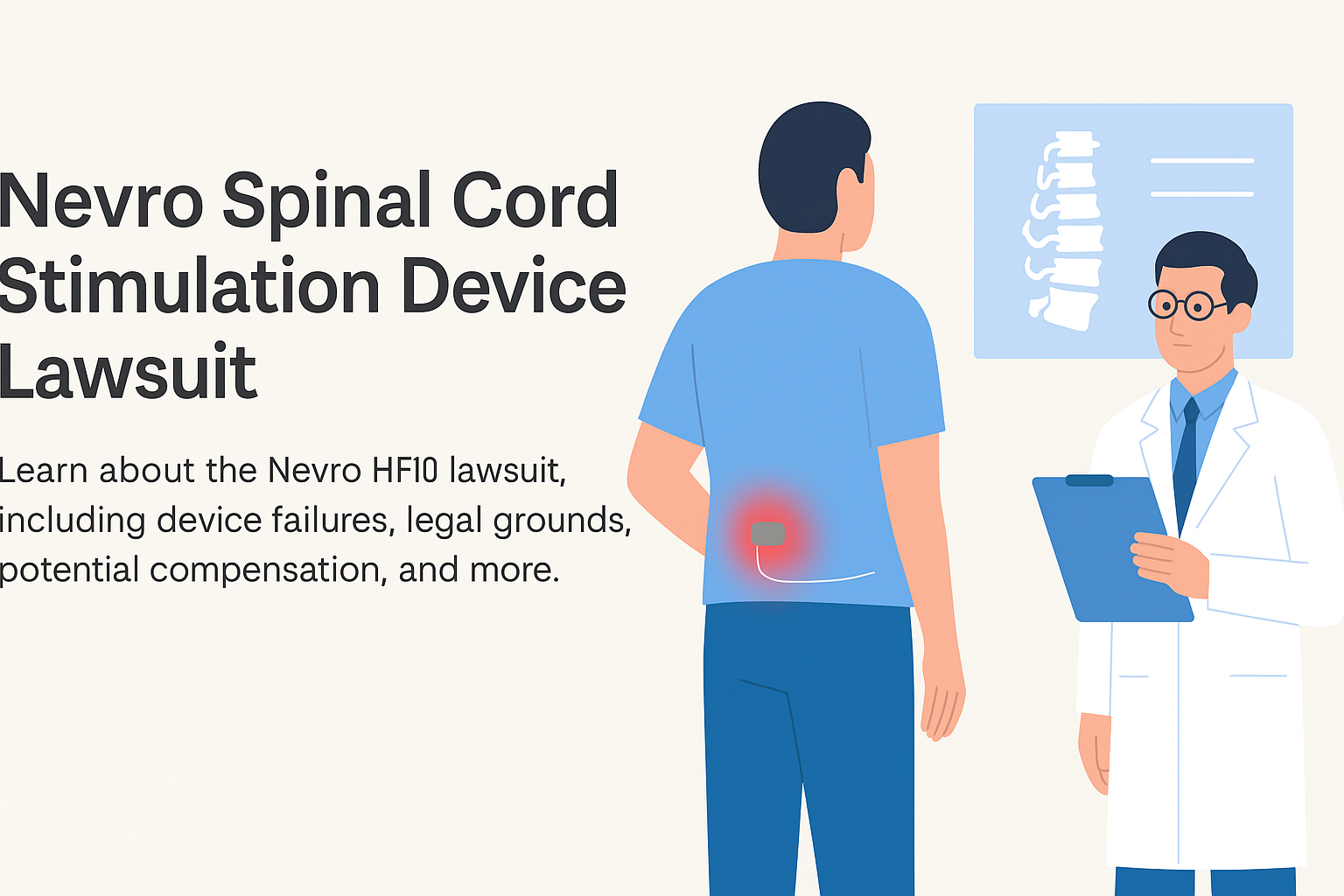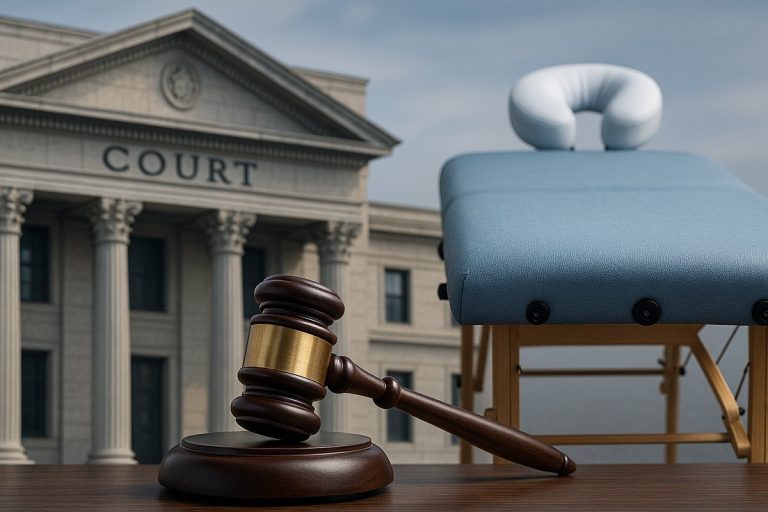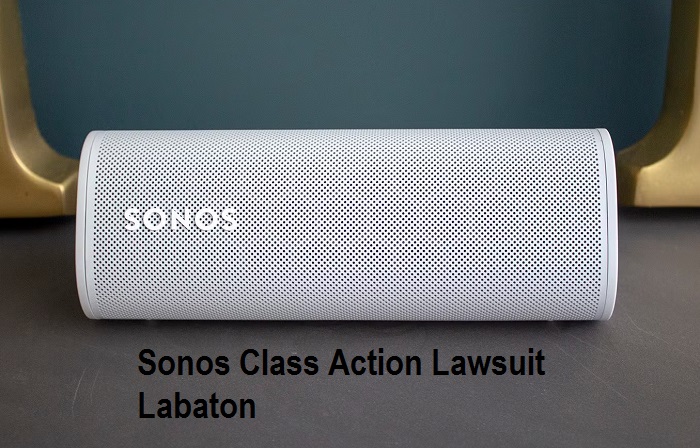You should know that the Nevro HF10 lawsuit pertains to U.S. patients who have an HF10 or HFX implant. It is essential to understand that the Nevro spinal cord stimulation device lawsuit primarily focuses on the safety and reliability of the device. Many users report loss of relief, shocks, skin pain, or infection after implant. You should note reports of revision surgery or complete removal. It is essential to recognise that family members often face financial pressure after a device failure. Many households record travel bills, wage loss, and home care fees. You should ask a simple question now. Do your records show similar device issues?
Why are users filing claims now?
You should be familiar with the core claim first. It is essential to know that plaintiffs allege defects, failure to warn, and negligence. Many attorneys argue that the promotion overstated benefits and hid material risk. You should see that lawyers review FDA adverse event reports for evidence of patterns. It is important to note that MAUDE entries encompass device faults that span multiple dates. Many journals also describe explant rates for spinal cord stimulators. You should connect those sources to your facts with care. Do your clinic notes match public risk data?
How does the Nevro HF10 spinal cord stimulation device work?
You should now learn about the general background to device operation. It is essential to understand how each part functions before identifying failures. Many readers ask what makes the Nevro HF10 different from other spinal cord stimulators. You should read this section to see its intended use and core technology.
What purpose does the Nevro HF10 device serve?
You should understand the goal before reviewing the lawsuit details. It is essential to note that the Nevro HF10 device is specifically designed to manage chronic back and leg pain. Many patients use it after other pain treatments fail. You should be aware that Nevro promoted the HF10 system as a high-frequency stimulator created to avoid tingling sensations known as paresthesia. The company claimed that the device provides continuous pain relief without discomfort. You should note that this promise attracted many patients seeking drug-free pain control. The HF10 device sends rapid electrical signals that disrupt pain messages travelling to the brain.
How does the Nevro HF10 system operate in the body?
First, focus on the components. It is essential to note that the HF10 system comprises electrodes, a lead wire, and a pulse generator. A surgeon places these parts near the spinal cord, under the skin. The pulse generator releases electrical energy through the leads. The system uses battery power to maintain programmed frequencies. You may ask about control. Patients receive a handheld controller to adjust stimulation levels. This feature was advertised as user-friendly and adaptable. Each electrical signal aims to block pain before it reaches sensory centres in the brain.
What concerns exist about device performance?
You should now look at performance data. It is essential to note that clinical studies in Pain Medicine and Neurosurgery journals have reported initial success rates exceeding 70%. Real-world results often show lower success rates over time. Some users report reduced relief within two years after implantation. You may ask why this decline occurs. Lead migration, battery failure, and scar tissue formation may interfere with electrical transmission. FDA adverse event reports mention unexpected shocks and recurrence of pain. The delicate placement of leads makes the system sensitive to body movement. Many users later require revision surgery after repeated malfunctions.
Repeated surgeries and hardware issues strengthen legal arguments about product defects. Detailed medical records help establish proof of harm in court. A clear understanding of the device’s operation enables patients to identify technical faults as the cause of personal injuries.
What problems have users reported with the Nevro device?
You should now connect device function to real user outcomes. It is important to identify problem patterns before you consider a fault. Numerous reports indicate recurring types of malfunctions and injuries.
What device malfunctions appear most often?
You should examine electrical faults first. Users report abrupt loss of pain relief and sudden shocks. Low battery life appears in multiple cases. Controller alerts sometimes occur without cause. Placement issues follow next. Lead migration disrupts signal delivery. Fractured leads appear after normal movement. Loose connections interrupt therapy without warning. You may ask about supporting evidence. FDA MAUDE reports document both device malfunctions and patient harm. Similar patterns emerge across numerous filings spanning several years.
Which medical complications raise concern?
You should now extend the review to include more than just electronics. Infections near the implant site have been reported in cases. Nerve pain often develops near the spine after implantation. Skin erosion above the generator appears rarely but requires attention. Some patients experience new back or leg pain after initial relief. The severity varies across cases. Many users undergo explant surgery after repeated problems. Revision procedures also occur within two years of the first implant. Consider a patient who experiences shocks, pain return, and swelling near the generator pocket. After failed reprogramming, the user proceeds to explant surgery. Public FDA data confirm the sequence across spinal cord stimulation devices.
How do real-world reports compare to studies?
You should compare research findings to patient experiences. Early clinical studies have shown success rates exceeding 70 per cent for high-frequency spinal cord stimulation. Real-world results often reveal lower levels of relief. Lead movement and scar tissue contribute to these differences. Patients frequently visit clinics for repeated reprogram sessions. Attorneys cite this gap between trials and daily outcomes to argue that warnings are incomplete. Device performance in registries also varies across centres. Peer-reviewed articles and FDA databases provide ongoing evidence that supports a detailed review of each claim.
Why are patients filing lawsuits against Nevro?
You should now link mechanical problems to legal reasons. Understanding the connection between harm and responsibility helps you evaluate your own case.
What core allegations do plaintiffs raise?
You should be familiar with the main allegations first. Plaintiffs claim design defects that compromise safety and durability. Failure to warn about known risks forms another core argument. Attorneys also raise negligence in product development and post-market monitoring. Warranty claims arise when repeated device faults violate performance promises. Internal company documents from other device cases often support these points. FDA adverse event data adds factual timelines showing notice and response to ongoing issues.
How do marketing claims factor into liability?
You should examine promotional materials next. Plaintiffs argue that claims of consistent relief overstated actual outcomes. Paresthesia-free therapy implied a lower risk than competing devices. Courts analyse whether these statements misled reasonable patients or doctors. Risk warnings must be presented in clear, unambiguous language to meet legal requirements. A brochure highlighting relief without equal space for side effects creates an imbalance. Physicians who rely on such materials may give incomplete consent information. Courts often treat that gap as a warning defect under product liability law.
Which facts strengthen an individual lawsuit?
You should gather a complete medical and procedural record. Include the implant date, model, and a record of removal. Clinic notes describing shocks, infections, or loss of pain add essential support. Photos of skin damage strengthen visible injury claims. Device interrogation reports verify malfunction timing. FDA MAUDE entries and peer-reviewed articles provide credible external references. Similar user experiences demonstrate a pattern of evidence that links defects to harm. Strong documentation enables attorneys to establish causation and accurately measure damages.
What legal grounds support the Nevro Spinal Cord Stimulation Device Lawsuit?
You should now connect patient complaints to formal legal categories. Understanding these foundations explains how attorneys present device cases in court.
What claims appear most often in Nevro HF10 lawsuits?
Product liability stands as the central claim. Attorneys argue that the HF10 system contained design or manufacturing flaws when sold. A design defect means the product remained dangerous even after proper assembly. A manufacturing defect occurs when some devices are left in production in an unsafe condition. Failure to warn forms another primary argument. Plaintiffs allege that Nevro failed to provide complete risk information to doctors and users. Negligence occurs when companies fail to conduct safety testing or disregard device complaints. Breach of warranty focuses on promises about safety and performance that failed after purchase.
How do federal rules and FDA records influence these claims?
Medical devices fall under oversight by the FDA’s Centre for Devices and Radiological Health. Companies must report adverse events through the MAUDE system. Attorneys review those records to prove that Nevro had prior notice of safety issues. Approval filings and public statements often reveal gaps between claims and compliance. Federal preemption sometimes limits specific design-defect claims. Failure-to-warn and negligence usually survive because they target communication duties, not design standards.
What evidence helps build a strong case?
Gather all medical records, implant data, and device logs. Keep written communication with Nevro staff or clinic technicians. Request FDA summaries that match your serial range. Retain every invoice for surgery and follow-up care. Detailed records enable attorneys to link harm to the defective product directly. Thorough documentation also supports fair damage calculations during litigation.
How do you qualify for a Nevro HF10 lawsuit?
You should first connect your medical history to clear eligibility rules. It is important to review practical checkpoints before you contact a lawyer. Many readers begin by confirming device details and symptom patterns.
What basic criteria apply?
You should confirm that a surgeon implanted a Nevro HF10 or HFX system in the United States. It is essential to verify that device problems caused measurable harm. Many users link their records to specific symptoms for clarity and accuracy. Focus on loss of pain relief, shocks, pocket pain, infection, or nerve injury. Confirm that a doctor recommended the revision or removal of the system. Ensure that symptoms continued despite several reprogram attempts. Evidence supports each of these criteria. FDA MAUDE reports list recurring malfunctions and patient injuries across numerous cases. Public filings show the same complications among users. Consider one clear example now. A patient who experiences loss of relief, feels shocks, and requires explant surgery within two years meets the eligibility conditions.
Which documents support your claim?
You should gather records before any legal consultation. It is essential to store every copy in one secure folder for review.
Include the implant card and device model.
Add operative notes and discharge summaries.
Keep clinic records describing shocks or pain recurrence.
Save device interrogation printouts.
Retain bills for surgery, pharmacy, and travel.
Attach absence letters and wage records.
Documentation strengthens both causation and damages. Clinical journals report explant rates for spinal cord stimulators within multi-year periods. Evidence from these studies helps experts compare your history to published outcomes.
How do deadlines affect eligibility?
You should check the statute of limitations in your state as soon as possible. It is necessary to review discovery rules that start the clock when defect awareness begins. Many states enforce limits between one and three years after injury. Confirm any statute of repose that blocks claims beyond a fixed window. Keep written proof of your first symptom, initial medical visit, and explant date. FDA guidance and state law define firm timelines that courts apply strictly. Act without delay to preserve your right to recovery and avoid dismissal for lateness.
What compensation can you seek through the Nevro HF10 case?
You should understand possible recovery before planning your claim. It is essential to link injuries and expenses to defined categories of damages. Many users overlook non-economic impacts when valuing claims.
What types of damages do lawsuits target?
Compensatory damages form the foundation of each case. Courts divide them into economic and non-economic groups. Economic damages include medical bills, surgery costs, wage loss, and replacement expenses. Non-economic damages account for pain, stress, and reduced quality of life. State laws differ on caps for these awards. Some allow juries full discretion when setting values. Punitive damages appear when the company shows reckless disregard for safety. Those awards punish negligence and discourage repeat conduct. Check your state’s case law for local precedent and limit levels.
How can you calculate fair compensation?
You should record each expense connected to treatment or revision care. Keep wage statements showing lost income. Obtain written medical opinions about long-term effects of nerve injury or multiple surgeries. Record daily pain levels to measure personal impact. Add travel receipts for clinic or specialist visits. Independent data supports your claim strength. Clinical studies in Pain Physician and Neuromodulation journals report revision rates between 20 and 30 percent. Those findings demonstrate the lasting burden of device failure for many patients.
How do settlements and trials differ?
You should know that most medical device lawsuits settle before trial. Settlement outcomes depend on injury severity and evidence quality. Mass tort cases permit individual awards under joint discovery. Class actions treat members as one group and apply shared compensation. Attorneys review case details to determine the best filing structure. Negotiations begin once document review and expert opinions conclude. Insurers and corporate counsel often evaluate settlement offers during this stage. Early preparation ensures stronger leverage for fair results.
Key Facts about the Nevro HF10 Lawsuit
| Category | Essential Information |
|---|---|
| Device Name | Nevro HF10 or HFX Spinal Cord Stimulation System |
| Primary Purpose | Chronic back and leg pain management through electrical pulses |
| Manufacturer | Nevro Corporation, based in California, United States |
| Reported Issues | Loss of pain relief, shocks, infections, battery failure, lead migration |
| Main Legal Claims | Design defect, failure to warn, negligence, breach of warranty |
| Typical Injuries | Nerve damage, infection, scar formation, chronic pain, surgical removal |
| Evidence Sources | FDA MAUDE database, medical journals, clinic records, device logs |
| Average Revision Rate | Clinical data show between 20% and 30% within two years |
| Filing Deadline | One to three years in most states after discovery of injury |
| Compensation Types | Medical costs, lost income, pain and suffering, punitive damages |
| Legal Pathways | Individual lawsuits, mass tort coordination, or multidistrict litigation |
| Current Status | Cases active in multiple U.S. courts with continued new filings |
| Recommended Next Step | Collect all records, consult a qualified attorney, act before deadlines |
What is the current status of Nevro HF10 litigation?
You should understand the overall posture before making decisions. It is essential to recognise current trends shaping legal strategies. Many readers seek clarity on filings, coordination, and court progress.
Where do cases stand across the United States?
Plaintiffs continue filing new cases in several states. Courts in multiple districts track device failure allegations and injury claims. Judges in some venues consider requests to coordinate actions for efficiency. Attorneys support consolidation to reduce duplicate discovery. Each plaintiff still maintains an individual claim under a mass tort framework. FDA MAUDE reports confirm ongoing adverse event entries for spinal cord stimulators. Peer-reviewed journals document revision and explant rates that support case validity. Together, these records present a clear picture of the legal landscape.
How do coordination and MDL requests affect your timeline?
A multidistrict litigation, or MDL, centralises discovery under one court. Coordination simplifies document review but preserves individual outcomes. Plaintiffs maintain separate damage models despite shared evidence. Courts assign unified deadlines for expert disclosure and depositions. Test cases often guide later settlement discussions. Public MDL data show that bellwether trials influence negotiation values. Understanding this process helps you anticipate case movement and timeline length.
What trends define settlements and trial posture right now?
Most spinal cord stimulator cases conclude through negotiated settlements. Values depend on injury depth, surgery history, and medical proof. Lawyers present device data and patient logs to support demands. Courts verify evidence under state product liability standards before approval. FDA adverse event data and medical journals strengthen plaintiffs’ arguments. Record preservation remains vital for future leverage. Acting now to secure documents safeguards your position during talks and trials.
How can legal experts help you with your Nevro HF10 claim?
You should understand the lawyer’s role before you contact a firm. It is important to know that legal professionals handle device cases through investigation and negotiation. Many readers ask why they need representation. You should use this section to identify clear reasons and measurable benefits.
What actions do attorneys take during the lawsuit process?
You should be aware that attorneys collect and analyse all relevant documents. It is essential to note that lawyers often request medical records, device reports, and FDA submissions. Many attorneys consult biomedical engineers to interpret data on defects. You should expect experts to evaluate electrical performance and lead stability. It is essential to note that attorneys also manage communication with manufacturers and insurers. Many law firms maintain databases of prior device cases to support claim modelling and analysis. You should understand that these records help identify trends in design failure and regulatory notices. Do you see how a lawyer builds your proof step by step?
How can an attorney protect your rights and compensation?
You should recognise that a lawyer ensures compliance with all procedural rules. It is essential to be aware that attorneys typically file before limitation deadlines expire. Many manage discovery to secure evidence before companies dispose of key materials. You should expect lawyers to negotiate settlements using medical evidence and wage records. It is essential to understand that strong counsel can demand compensation that matches the documented loss. Many firms work on a contingency basis, which removes the risk of upfront costs. You should confirm the fee details before signing any agreement. Do you realise that legal help can transform complex regulations into a clear recovery path?
What practical steps should you take before contacting a lawyer?
You should organise all your records before the consultation. It is important to know that attorneys rely on precise documentation. Many firms request a complete timeline of your implant, symptoms, and surgeries. Include serial numbers, device reports, and images whenever possible. It is important to know that a clear presentation saves time during case review. Many firms offer free evaluations, which enable you to assess the strength of your claim early. You should consider reaching out soon after reading this article. Acting quickly enhances the quality of your evidence and strengthens your position under state law. Do you see how preparation supports faster legal action and better outcomes?
What should you do next if you experience complications with the Nevro HF10?
You should now connect your knowledge to action. It is essential to understand that your next steps can significantly impact the success of your claim. Many readers wait for too long before collecting evidence. You should act early to secure your rights.
How can you take control of your health first?
Contact your doctor immediately if you experience any symptoms. It is essential to know that medical confirmation of device malfunction strengthens your case. Many physicians can run diagnostic checks to detect battery or lead problems. You should ask for printed reports after every clinic visit. It is important to know that an independent evaluation helps rule out unrelated causes of pain. Many clinics can refer you to specialists who handle device revision or removal. You should keep all tests and invoices together. A consistent record shows the link between harm and product defect. Do you see how organised medical care supports both recovery and legal proof?
What early legal actions should you consider?
You should consult a qualified product liability attorney once your condition stabilises. It is important to know that early advice helps you avoid missed deadlines. Many firms track ongoing Nevro cases and are familiar with court procedures. You should confirm that the lawyer has experience with spinal cord stimulator claims. It is essential to understand that skilled attorneys determine whether your facts align with mass tort coordination or individual filing. Many lawyers can send preservation letters to Nevro to protect key device data. You should stay involved and review each filing your lawyer submits. Do you understand how active participation improves your claim control?
How can you protect others while seeking justice?
You should share accurate information about your experience. It is essential to recognise that honest testimony can contribute to medical safety reviews. Many patients report adverse events to the FDA through official channels. You should help regulators collect evidence that prevents future harm. It is essential to note that lawsuits also prompt companies to revise their designs and labelling. Many public settlements include safety commitments that help new patients. Remember that your actions today can protect someone tomorrow. Justice grows stronger when informed users speak up together. Do you see how your effort can improve patient safety beyond your own case?
Call to Action
You should not face complex medical and legal issues alone. It is essential to know that professional help can guide you through each stage of the process. Many law firms offer free case reviews for Nevro HF10 patients nationwide. You should gather your documents now and contact a trusted attorney for evaluation. Taking prompt action safeguards your rights, secures evidence, and sets your path toward fair compensation in motion.
What final steps should you take after learning about the Nevro Spinal Cord Stimulation Device Lawsuit?
You should close your reading with a clear decision. It is essential to understand that taking timely action protects your right to a fair recovery. Many users face pain, infection, or loss of relief after device failure. You should document every symptom and gather all medical records now. It is essential to know that accurate proof supports your case and helps your attorney build strong arguments. Many courts depend on detailed evidence when judging medical device claims. You should also stay informed about updates to the Nevro HF10 lawsuit nationwide. It is essential to know that attorneys continue to review new patient reports under the Nevro spinal cord stimulation device lawsuit category. You should consult a qualified lawyer to confirm your eligibility and proceed with confidence today.




